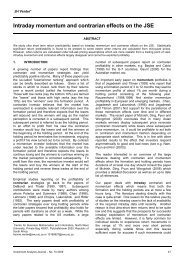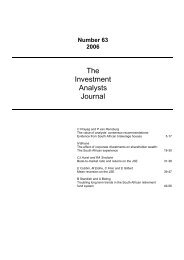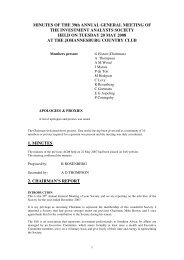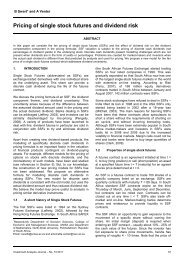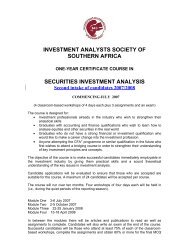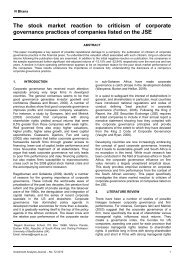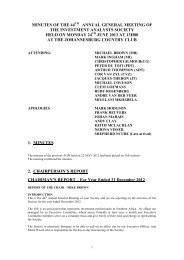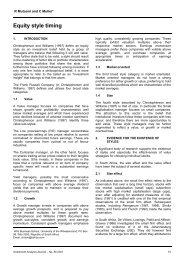Accounting is Broken - Investment Analysts Journal
Accounting is Broken - Investment Analysts Journal
Accounting is Broken - Investment Analysts Journal
Create successful ePaper yourself
Turn your PDF publications into a flip-book with our unique Google optimized e-Paper software.
Stern Stewart & Co.<br />
E VA = NOPAT - (WACC% x $Total Capital)<br />
= $ 4 million - ( 10% x $100 million )<br />
- $ 6 million = $ 4 million - $10 million<br />
When EVA <strong>is</strong> measure d<br />
a c c o rding to the proposed<br />
new rules it provides<br />
the reliable signals<br />
that investors and managers<br />
have always needed<br />
but rarely gotten to<br />
judge the value of<br />
re s t ructuring maneuv<br />
e r s .<br />
The proposed new<br />
accounting also should<br />
have a considerable<br />
appeal to the numero u s<br />
astute investors that<br />
have long championed<br />
cash accounting as more<br />
reliable than book<br />
re p o rt i n g .<br />
Accountants have an<br />
u n f o rtunate tendency to<br />
mix changes in stock<br />
values with flows. In<br />
the new accounting,<br />
re c u rring cash flows go<br />
t h rough NOPAT, and<br />
adjustments to stock<br />
values are relegated to<br />
the balance sheet.<br />
One implication of th<strong>is</strong><br />
t reatment <strong>is</strong> that noncash<br />
re s t ru c t u r i n g<br />
c h a rges have no eff e c t<br />
on a firm ’s EVA .<br />
21<br />
Sale - $ 4 million - $100 million<br />
Loss<br />
- $ 25 million<br />
= - $ 25 million - ( 10% x $ 0 million )<br />
- $25 million = - $ 25 million - $ 0 million<br />
Add-Back + $ 25 million +$ 25 million<br />
= $ 0 million - ( 10% x $ 25 million )<br />
- $ 2.5 million = $ 0 million - $2.5 million<br />
With the proposed double add-back accounting, economic profit <strong>is</strong> correctly measured as a<br />
loss of $2.5 million. It <strong>is</strong> a loss because the company <strong>is</strong> stuck with $25 million in unre c o u p e d<br />
capital on its balance sheet. Investors put $100 million in capital into the business line and<br />
have now gotten back only $75 million. At a 10% cost of capital they are out the $2.5 million<br />
a year they could have earned on the $25 million diff e rence. The re s t ructuring cannot<br />
erase the loss in value from the original dec<strong>is</strong>ion to enter the business.<br />
The important point at th<strong>is</strong> juncture, however, <strong>is</strong> not that EVA <strong>is</strong> still negative, but that it has<br />
i n c reased by $3.5 million, from a loss of $6 to a lesser loss of $2.5. That <strong>is</strong> the measure of<br />
the w<strong>is</strong>dom of the current dec<strong>is</strong>ion to exit the business line. The measure of the market value<br />
added by the exit dec<strong>is</strong>ion <strong>is</strong> the capitalized value of the $3.5 million EVA gain at the firm ’s<br />
10% cost of capital which, as expected, <strong>is</strong> $35 million. All in all, when EVA <strong>is</strong> measure d<br />
a c c o rding to the proposed new rules it provides the reliable signals that investors and managers<br />
have always needed but rarely gotten to judge the value of re s t ructuring maneuvers.<br />
The proposed new accounting also should have a considerable appeal to the numero u s<br />
astute investors that have long championed cash accounting as more reliable than book<br />
re p o rting. Consider that when the dust settles with all the adjustments just described, the<br />
net effect boils down to two simple journal entries. First, the company’s cash account <strong>is</strong><br />
debited (increased) for the $75 million in sale proceeds, and second, the company’s capital<br />
account <strong>is</strong> credited (reduced) by the same $75 million, leaving a residual $25 million in capital<br />
on the firm ’s balance sheet. 17<br />
Both entries are pure cash, and avoid the recognition of<br />
an arbitrary loss or gain compared to book value. 18<br />
Sweeping capital gains and losses off the income statement makes sense because capital<br />
transactions by their nature should swing through the capital account. Accountants have an<br />
u n f o rtunate tendency to mix changes in stock values with flows. In the new accounting,<br />
re c u rring cash flows go through NOPAT, and adjustments to stock values are relegated to<br />
the balance sheet.<br />
One implication of th<strong>is</strong> treatment <strong>is</strong> that non-cash re s t ructuring charges have no effect on<br />
a firm ’s EVA. As the charges do not affect cash flow, they cannot affect value, and so they<br />
do not affect EVA either. A good example of a completely inconsequential, non-cash<br />
re s t ructuring charge <strong>is</strong> “goodwill impairment.” Under recently promulgated rules, accountants<br />
must periodically reassess the value of the goodwill premium over book value that<br />
companies have paid to acquire other firms. If the current value of the goodwill <strong>is</strong> found to<br />
be less than what was paid, the goodwill must be written down and charged to earnings . 1 9<br />
1 7<br />
In the measurement of EVA it <strong>is</strong> assumed that the $75 million sale proceeds are used to re t i re the firm ’s debt and equity in targ e t<br />
capital stru c t u re pro p o rtions, and that the investors earn the cost of capital on those funds through reinvestment in a comparably<br />
r<strong>is</strong>ky stock and bond portfolio. If the proceeds are retained for some other purpose management should still think of the funds as<br />
having been paid out and then brought back in at the cost of capital, and the new pro j e c t ’s EVA should be evaluated on its own merits<br />
as a separate matter. Th<strong>is</strong> <strong>is</strong> another manifestation of the principle to separate operating and financing dec<strong>is</strong>ions.<br />
1 8<br />
The same treatment would apply if a gain were re g i s t e red on the sale. The gain <strong>is</strong> ignored on the income statement, but the excess<br />
of sale proceeds over book value leads to a net overall reduction in capital that adds to EVA through a negative capital charg e .<br />
1 9<br />
I ro n i c a l l y, accountants will not write-up the book value of goodwill if it <strong>is</strong> found to have appreciated in value, yet another sign of<br />
their conservative bias.




